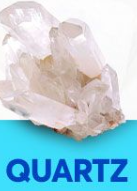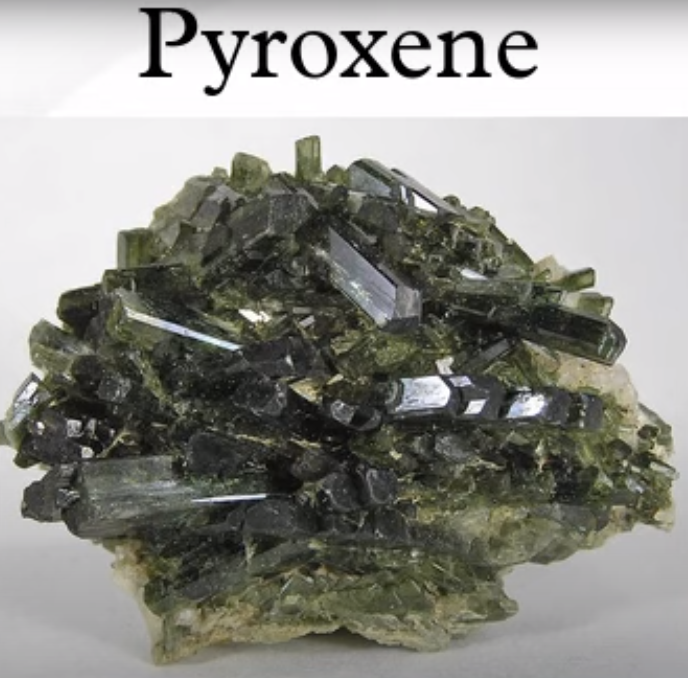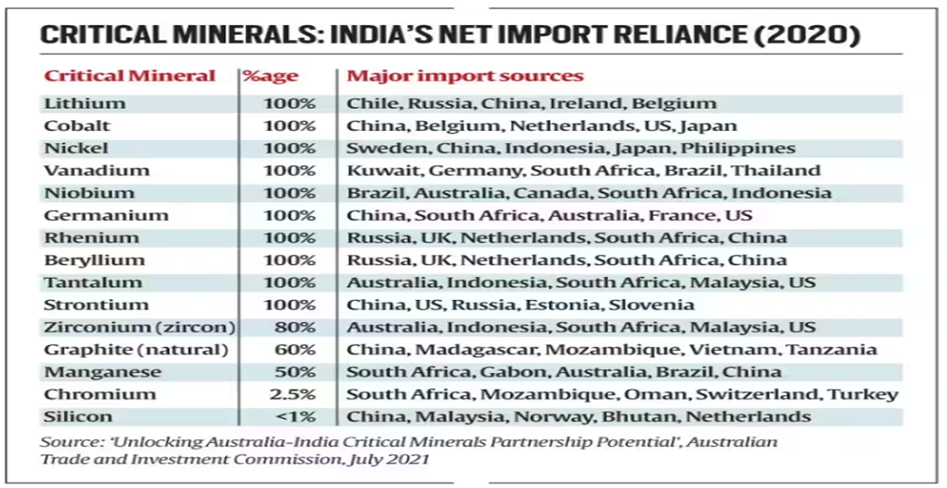Earth’s Resources and India’s Minerals: An Overview
Inorganic and Organic compounds are naturally occurring substances with structured atomic arrangements, specific chemical compositions, and distinct physical properties. Major elements and their traits, challenges in mining critical resources, and the significance of deep-seated minerals are highlighted. India’s mineral wealth and its entry into the Critical Resources Alliance are discussed, along with challenges in mining deep-seated minerals.
Mineral Genesis: Elements, Formation, and Earth’s Composition
A naturally occurring chemical compound found in Earth’s rocks, with atoms arranged in distinctive three-dimensional patterns. Their unique elements and arrangements dictate their appearance and properties.
- Composition of Elements: Typically, compounds made up of two or more elements, although instances of single-element compounds like sulfur, copper, silver, gold, and graphite are not uncommon.
- Elemental States: Single-element compounds exist in solid form within the Earth’s outer layer, while in the Earth’s interior, they are in a hot, molten state.
- Earth’s Elemental Composition: A substantial portion, approximately 98%, of the Earth’s crust is primarily constituted by eight elements—oxygen, silicon, aluminum, iron, calcium, sodium, potassium, and magnesium.
-
- The remaining elements include titanium, hydrogen, phosphorus, manganese, sulfur,carbon, nickel, and various others.
- Origins: The primary source of all compounds lies in the high-temperature magma within the Earth’s interior.
-
- These minerals begin to crystallize when the magma cools, forming a systematic sequence of mineral compositions that ultimately solidify to create Rocks.
- Organic Mineral Forms: Certain minerals, such as coal, petroleum, and natural gas, are organic in nature and can be found in solid, liquid, and gaseous states, respectively.
Physical Characteristics of Minerals
- External Crystal Form: This aspect of minerals is determined by their internal molecular arrangement, resulting in various shapes such as cubes, octahedrons, hexagonal prisms, and more.
- Cleavage: Cleavage denotes a mineral’s tendency to break along specific directions, creating relatively flat surfaces.
-
- This property is an outcome of the mineral’s internal molecular structure, and a mineral may exhibit cleavage in one or more directions at various angles.
- Fracture: In cases where a mineral’s internal molecular arrangement is exceedingly intricate, there are no distinct planes for molecules to follow during breakage.
-
- Consequently, the mineral fractures irregularly, deviating from the concept of cleavage.
- Lustre: Lustre refers to the visual appearance of a mineral, irrespective of its color.
- Each mineral possesses a unique lustre, which can range from being metallic, silky, glossy, and so forth.
- Colour: Some minerals exhibit distinct colors, determined by their underlying molecular structures.
- Conversely, certain minerals acquire their coloration from impurities.
- For instance, quartz may appear in various colors, including white, green, red, and yellow, due to the presence of impurities.
- Streak: Streak represents the color of a mineral’s ground powder.
- This color may match the mineral’s actual color or differ from it.
- For example, malachite, which is green, produces a green streak, while fluorite, which can be purple or green, leaves a white streak.
- Transparency: Transparency categorizes minerals based on how light interacts with them.
- Transparent allow light to pass through clearly, making objects visible.
- Opaque block the passage of light entirely.
- Structure: The structure of minerals pertains to the specific arrangement of individual crystals.
-
- They can exhibit fine, medium, or coarse-grained structures, and some may have fibrous arrangements, which can be separable, divergent, or Radiating.
- Hardness: Hardness is a mineral’s resistance to being scratched.
- It is measured on a scale from 1 to 10, with ten minerals serving as reference points for assessing hardness.
- These reference minerals include talc, gypsum, calcite, fluorite, apatite, feldspar, quartz, topaz, corundum, and diamond.
Characteristics of Minerals : Forms of Crystal
Feldspar
- Composition: All feldspars contain silicon and oxygen, with sodium, potassium, calcium, aluminum, and others in specific types.
- Abundance: Feldspar comprises half of the Earth’s crust.
- Color: Typically, feldspar appears in light cream to salmon pink hues.
- Use: It plays a crucial role in ceramics and glass production.
Quartz
- Constituents: Quartz is a vital component of sand and granite, mainly composed of silica.
- Hardness: This mineral is exceptionally hard and nearly insoluble in water.
- Color: It is usually white or colorless and finds applications in radio and radar technologies.
- Significance: Quartz is a key component in granite formations.
Pyroxene
- Ingredients: Pyroxene consists of calcium, aluminum, magnesium, iron, and silica.
- Earth’s Composition: Pyroxene constitutes approximately 10% of the Earth’s crust.
- Appearance: It is commonly found in meteorites and exhibits green or black coloration.
Amphibole
- Composition: It majorly comprises aluminum, calcium, silica, iron, and magnesium.
- Crustal Presence: It accounts for around 7% of the Earth’s crust.
- Use: These minerals, appearing in green or black shades, have applications in the asbestos industry. Hornblende is a variation of amphiboles.
Mica
- Makeup: Mica is composed of elements like potassium, aluminum, magnesium, iron, and silica.
- Crustal Share: It makes up about 4% of the Earth’s crust and is commonly found in igneous and metamorphic rock formations.
- Applications: It is utilized in electrical instruments.
Olivine
- Components: Olivine primarily consists of magnesium, iron, and silica.
- Use: This mineral is employed in jewellery and often presents as a greenish crystal. It’s commonly found in basaltic rock.

Other Minerals: Various minerals, including chlorite, calcite, magnetite, haematite, bauxite, and barite, are also found in varying quantities within rocks.
Mineral Classification: Metals and Non-Metals in Construction
- Categories: Metallic minerals encompass three categories—precious metals (e.g., gold, silver, platinum), ferrous metals (like iron, often mixed with other metals to form different types of steel), and non-ferrous metals (e.g., copper, lead, zinc, tin, aluminum).
Non-Metallic Minerals
- Characteristics: Non-metallic minerals lack metal content.
- Examples include sulphur, phosphates, and nitrates.
- Cement: Cement, a mixture of non-metallic minerals, is widely used in construction and related industries.
India’s Critical Minerals: Challenges and Deep-Seated Wealth |
Critical Minerals Definition
Their scarcity or limited availability in specific regions can pose significant risks to supply chains and result in vulnerability and disruption. Rising Demand for Critical Metals
India’s Mineral Wealth
|
Prelims(PYQ)
1. Match List-I with List-II and select the correct answer: (1997)
List-I List-II
(Minerals) (Typical areas of occurrence)
-
- Coal 1. Bhandara
- Gold 2. Karanpura
- Mica 3. Hutti
- Manganese 4. Nellore
Codes:
(a) A – 1; B – 3; C – 2; D – 4
(b) A – 2; B – 3; C – 4; D – 1
(c) A – 3; B – 4; C – 2; D – 1
(d) A – 2; B – 1; C – 4; D –3
Ans. b
2. Which of the following minerals are found in a natural way in the state of Chhattisgarh? (2008)
- Bauxite
- Dolomite
- Iron ore
- Tin
Select the correct answer using the code given below:
Codes:
(a) 1, 2 and 3 only
(b) 1 and 3 only
(c) 2 and 4 only
(d) 1, 2, 3 and 4
Ans. d
3. With reference to the management of minor minerals in India, consider the following statements : (2019)
- Sand is a ‘minor mineral’ according to the prevailing law in the country.
- State Governments have the power to grant mining leases of minor minerals, but the powers regarding the formation of rules related to the grant of minor minerals lie with the Centre Government.
- State Governments have the power to frame rules to prevent illegal mining of minor minerals. Which of the statements given above is/are correct?
(a) 1 and 3 only
(b) 2 and 3 only
(c) 3 only
(d) 1, 2 and 3 only
Ans. a
4. Consider the following minerals: (2020)
- Bentonite
- Chromite
- Kyanite
- Sillimanite
In India, which of the above is/are officially designated as major minerals?
(a) 1 and 2 only
(b) 4 only
(c) 1 and 3 only
(d) 2, 3 and 4 only
Ans. d
Mains (PYQ)
1. Despite India being one of the countries of Gondwanaland, its mining industry contributes much less to its Gross Domestic Product (GDP) in percentage. Discuss. (2021)
2. “In spite of adverse environmental impact, coal mining is still inevitable for development”. Discuss. (2017)

 GS Foundation
GS Foundation Optional Course
Optional Course Combo Courses
Combo Courses Degree Program
Degree Program



















